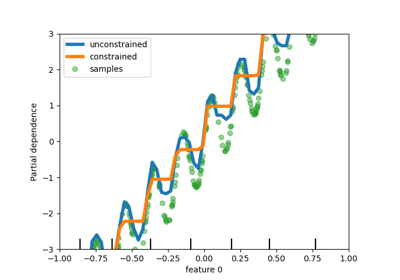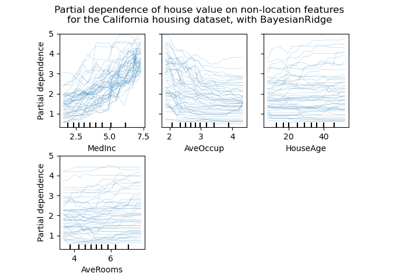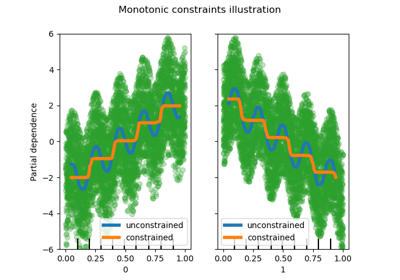sklearn.inspection.plot_partial_dependence¶
-
sklearn.inspection.plot_partial_dependence(estimator, X, features, *, feature_names=None, target=None, response_method='auto', n_cols=3, grid_resolution=100, percentiles=0.05, 0.95, method='auto', n_jobs=None, verbose=0, line_kw=None, contour_kw=None, ax=None, kind='average', subsample=1000, random_state=None)[source]¶ Partial dependence (PD) and individual conditional expectation (ICE) plots.
Partial dependence plots, individual conditional expectation plots or an overlay of both of them can be plotted by setting the
kindparameter. Thelen(features)plots are arranged in a grid withn_colscolumns. Two-way partial dependence plots are plotted as contour plots. The deciles of the feature values will be shown with tick marks on the x-axes for one-way plots, and on both axes for two-way plots.Read more in the User Guide.
Note
plot_partial_dependencedoes not support using the same axes with multiple calls. To plot the the partial dependence for multiple estimators, please pass the axes created by the first call to the second call:>>> from sklearn.inspection import plot_partial_dependence >>> from sklearn.datasets import make_friedman1 >>> from sklearn.linear_model import LinearRegression >>> from sklearn.ensemble import RandomForestRegressor >>> X, y = make_friedman1() >>> est1 = LinearRegression().fit(X, y) >>> est2 = RandomForestRegressor().fit(X, y) >>> disp1 = plot_partial_dependence(est1, X, ... [1, 2]) >>> disp2 = plot_partial_dependence(est2, X, [1, 2], ... ax=disp1.axes_)
Warning
For
GradientBoostingClassifierandGradientBoostingRegressor, the'recursion'method (used by default) will not account for theinitpredictor of the boosting process. In practice, this will produce the same values as'brute'up to a constant offset in the target response, provided thatinitis a constant estimator (which is the default). However, ifinitis not a constant estimator, the partial dependence values are incorrect for'recursion'because the offset will be sample-dependent. It is preferable to use the'brute'method. Note that this only applies toGradientBoostingClassifierandGradientBoostingRegressor, not toHistGradientBoostingClassifierandHistGradientBoostingRegressor.- Parameters
- estimatorBaseEstimator
A fitted estimator object implementing predict, predict_proba, or decision_function. Multioutput-multiclass classifiers are not supported.
- X{array-like or dataframe} of shape (n_samples, n_features)
Xis used to generate a grid of values for the targetfeatures(where the partial dependence will be evaluated), and also to generate values for the complement features when themethodis'brute'.- featureslist of {int, str, pair of int, pair of str}
The target features for which to create the PDPs. If
features[i]is an integer or a string, a one-way PDP is created; iffeatures[i]is a tuple, a two-way PDP is created (only supported withkind='average'). Each tuple must be of size 2. if any entry is a string, then it must be infeature_names.- feature_namesarray-like of shape (n_features,), dtype=str, default=None
Name of each feature;
feature_names[i]holds the name of the feature with indexi. By default, the name of the feature corresponds to their numerical index for NumPy array and their column name for pandas dataframe.- targetint, default=None
In a multiclass setting, specifies the class for which the PDPs should be computed. Note that for binary classification, the positive class (index 1) is always used.
In a multioutput setting, specifies the task for which the PDPs should be computed.
Ignored in binary classification or classical regression settings.
- response_method{‘auto’, ‘predict_proba’, ‘decision_function’}, default=’auto’
Specifies whether to use predict_proba or decision_function as the target response. For regressors this parameter is ignored and the response is always the output of predict. By default, predict_proba is tried first and we revert to decision_function if it doesn’t exist. If
methodis'recursion', the response is always the output of decision_function.- n_colsint, default=3
The maximum number of columns in the grid plot. Only active when
axis a single axis orNone.- grid_resolutionint, default=100
The number of equally spaced points on the axes of the plots, for each target feature.
- percentilestuple of float, default=(0.05, 0.95)
The lower and upper percentile used to create the extreme values for the PDP axes. Must be in [0, 1].
- methodstr, default=’auto’
The method used to calculate the averaged predictions:
'recursion'is only supported for some tree-based estimators (namelyGradientBoostingClassifier,GradientBoostingRegressor,HistGradientBoostingClassifier,HistGradientBoostingRegressor,DecisionTreeRegressor,RandomForestRegressorbut is more efficient in terms of speed. With this method, the target response of a classifier is always the decision function, not the predicted probabilities. Since the'recursion'method implicitely computes the average of the ICEs by design, it is not compatible with ICE and thuskindmust be'average'.'brute'is supported for any estimator, but is more computationally intensive.'auto': the'recursion'is used for estimators that support it, and'brute'is used otherwise.
Please see this note for differences between the
'brute'and'recursion'method.- n_jobsint, default=None
The number of CPUs to use to compute the partial dependences. Computation is parallelized over features specified by the
featuresparameter.Nonemeans 1 unless in ajoblib.parallel_backendcontext.-1means using all processors. See Glossary for more details.- verboseint, default=0
Verbose output during PD computations.
- line_kwdict, default=None
Dict with keywords passed to the
matplotlib.pyplot.plotcall. For one-way partial dependence plots.- contour_kwdict, default=None
Dict with keywords passed to the
matplotlib.pyplot.contourfcall. For two-way partial dependence plots.- axMatplotlib axes or array-like of Matplotlib axes, default=None
If a single axis is passed in, it is treated as a bounding axes and a grid of partial dependence plots will be drawn within these bounds. The
n_colsparameter controls the number of columns in the grid.If an array-like of axes are passed in, the partial dependence plots will be drawn directly into these axes.
If
None, a figure and a bounding axes is created and treated as the single axes case.
New in version 0.22.
- kind{‘average’, ‘individual’, ‘both’}, default=’average’
Whether to plot the partial dependence averaged across all the samples in the dataset or one line per sample or both.
kind='average'results in the traditional PD plot;kind='individual'results in the ICE plot.
Note that the fast
method='recursion'option is only available forkind='average'. Plotting individual dependencies requires using the slowermethod='brute'option.New in version 0.24.
- subsamplefloat, int or None, default=1000
Sampling for ICE curves when
kindis ‘individual’ or ‘both’. Iffloat, should be between 0.0 and 1.0 and represent the proportion of the dataset to be used to plot ICE curves. Ifint, represents the absolute number samples to use.Note that the full dataset is still used to calculate averaged partial dependence when
kind='both'.New in version 0.24.
- random_stateint, RandomState instance or None, default=None
Controls the randomness of the selected samples when subsamples is not
Noneandkindis either'both'or'individual'. See Glossary for details.New in version 0.24.
- Returns
- display
PartialDependenceDisplay
- display
See also
partial_dependenceCompute Partial Dependence values.
PartialDependenceDisplayPartial Dependence visualization.
Examples
>>> from sklearn.datasets import make_friedman1 >>> from sklearn.ensemble import GradientBoostingRegressor >>> X, y = make_friedman1() >>> clf = GradientBoostingRegressor(n_estimators=10).fit(X, y) >>> plot_partial_dependence(clf, X, [0, (0, 1)])





